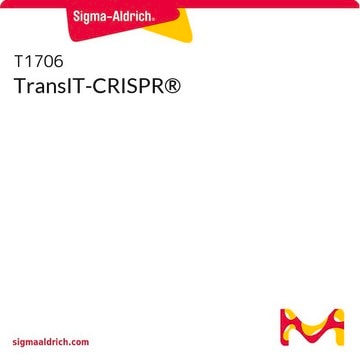CRISPRPL01
CRISPR GUS GAPDH Reporter Control for Monocots
About This Item
Polecane produkty
rekombinowane
expressed in E. coli
Poziom jakości
opakowanie
vial of 50 μL
stężenie
20 ng/μL in TE buffer; DNA (1μg of plasmid DNA)
Zastosowanie
CRISPR
selection
kanamycin
Warunki transportu
dry ice
temp. przechowywania
−20°C
Opis ogólny
CRISPR Plant Cas9 products are intended for Agrobacterium-mediated plant transformation. The products are based on the type IIA CRISPR-Cas9 derived from Streptococcus pyogenes. The native Cas9 coding sequence is codon optimized for expression in monocots and dicots, respectively. The monocot Cas9 constructs contain a monocot U6 promoter for sgRNA expression, and the dicot Cas9 constructs contain a dicot U6 promoter.
Arabidopsis seedlings were germinated in 6 well tissue culture plates. The seedlings were infected with Agrobacterium which had the CRISPR plasmids with a GUS reporter. After 3-4 days of transfection the GUS expression was detected. b-glucuronidase (GUS) is an enzyme that hydrolyzes colorless glucuronides to yield colored product
Zastosowanie
- To verify successful integration of T-DNA in plant genome
- GUS receptor wheat gGAPDH control for monocots for Agrobacterium mediated transformation
Cechy i korzyści
- Low cost, genome editing option compared to other methods.
- Easy to use
- Online ordering
- Ready to ship in 2 days
Komponenty
Keep reagent tubes closed when not in use.
Practice aseptic lab technique to avoid DNase contamination.
Zasada
Inne uwagi
Informacje prawne
Kod klasy składowania
12 - Non Combustible Liquids
Klasa zagrożenia wodnego (WGK)
WGK 1
Temperatura zapłonu (°F)
Not applicable
Temperatura zapłonu (°C)
Not applicable
Certyfikaty analizy (CoA)
Poszukaj Certyfikaty analizy (CoA), wpisując numer partii/serii produktów. Numery serii i partii można znaleźć na etykiecie produktu po słowach „seria” lub „partia”.
Masz już ten produkt?
Dokumenty związane z niedawno zakupionymi produktami zostały zamieszczone w Bibliotece dokumentów.
Protokoły
ZFNs and CRISPR/Cas9 advance targeted genome editing, opening new research avenues.
ZFN i CRISPR/Cas9 rozwijają ukierunkowaną edycję genomu, otwierając nowe możliwości badawcze.
Powiązane treści
Explore technology and reagent portfolios for plant breeding workflows, accelerating the development of new crop varieties.
Nasz zespół naukowców ma doświadczenie we wszystkich obszarach badań, w tym w naukach przyrodniczych, materiałoznawstwie, syntezie chemicznej, chromatografii, analityce i wielu innych dziedzinach.
Skontaktuj się z zespołem ds. pomocy technicznej







